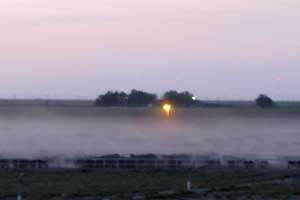Environmental scientists find antibiotics, bacteria, resistance genes in feedlot dust

After testing dust in the air near cattle feedlots in the Southern High Plains, researchers at The Institute of Environmental and Human Health at Texas Tech University found evidence of antibiotics, feedlot-derived bacteria and DNA sequences that encode for antibiotic resistance.
The study was published online in the National Institutes of Environmental Science's peer-reviewed journal, Environmental Health Perspectives. The research was funded through a grant from Texas Tech's College of Arts and Sciences. It is the first study documenting aerial transmission of antibiotic resistance from an open-air farm setting.
Phil Smith, an associate professor of terrestrial ecotoxicology at the institute, said that while scientists couldn't assess if the amounts of these materials were dangerous to human health, it helped explain a previously uncharacterized pathway by which antibiotic-resistant bacteria could travel long distances into places inhabited by humans.
The findings come weeks after a report commissioned by British Prime Minister David Cameron concluded that failure to battle drug-resistant infections and their causes could result in 10 million extra deaths a year by 2050 at a cost of $100 trillion to the global economy.
"You can look in the news, and people are raising red flags about antibiotic resistance all the time," Smith said. "Microbes are pretty promiscuous with their genetic information, and they share it across species fairly easily. We know it's there. We know what causes it, but we don't have a really good handle on how it's transmitted and how it moves in the environment. This is an attempt to provide better clarity on that issue.
"Everyone is fairly certain antibiotic resistance comes from extensive use of antibiotics in animal-based agriculture. About 70 percent of all antibiotics used are for animal agricultural purposes. Overuse contributes to antibiotic resistance. But how does it happen? How does it get from where the drugs are used into the human environment and natural environment?"

Smith said scientists collected air samples upwind and downwind of each feedlot. After analysis, they found greater amounts of bacteria, antibiotics and DNA sequences responsible for antibiotic resistance downwind of the feedlots compared to upwind, which helped scientists determine the source of the materials they found.
Because the antibiotics are present on the particulate matter with bacteria, the selective pressure for bacteria to retain their resistance remains during their flight, said Greg Mayer, an associate professor of molecular toxicology at the institute.
With wind blowing regularly on the Southern High Plains, the antibiotics and bacteria can travel on the dust and particulate matter far from the original starting point at the feedlot. Add the infamous West Texas dust storms into the picture, and these materials have the potential to travel hundreds of miles into cities and towns, and possibly around the globe.
"I think implications for the spread of some feedlot-derived, antibiotic-resistant bacteria into urban areas is paramount to the research," Mayer said. "Now, we haven't yet taken samples from an urban area to determine whether bacteria from that particulate matter originated from feedlots or whether it still has antibiotic resistant bacteria on it. However, this study is proof of the principle that antibiotic-resistant bacteria could plausibly travel through the air.
"Further studies are now needed to show where the particulate matter is traveling and what is happening to its passengers when it gets there."
Journal information: Environmental Health Perspectives
Provided by Texas Tech University
















